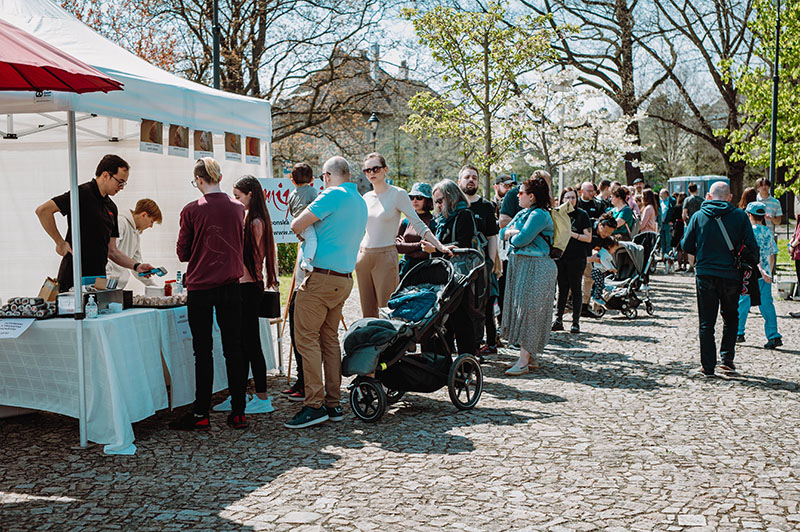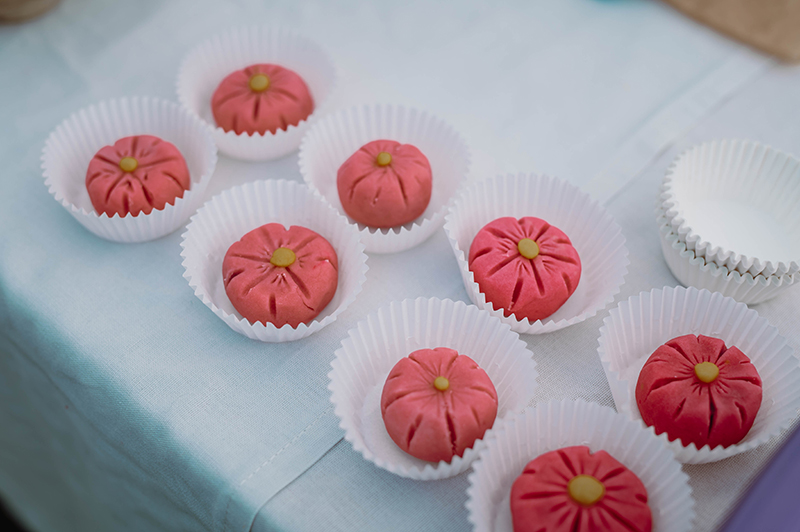Discover the Magic of Japan
Hanami
It's May and everything's in bloom
Hanami
Dear friends!
It is May and everything around us has blossomed. The trees are fragrant and their branches full of flowers beckon: Come sit under us and look at us! We are beauty! Do you know that in Japan, they have a special word for looking at the blossoms of trees? Yes they do and the word has become one of the most popular one even for me, a foreigner. Hanami. 花見. Hana is the character for flower, but in this case people mean cherry blossoms. Sakura blossoms seem to express everything about life, about the nation, about the world. In Japan, they even have a news program dedicated solely to news about where the cherry blossoms are blooming, where they are in their top bloom and where they are already falling. Sakura news is news that is highly watched. It is the important news of the day! The dazzling images of cherry blossom alleys must fill the heart of everyone who looks at them, but the Japanese are most moved when the petals of the flowers are falling from the trees and the wind plays with them. Dreamily, they recall the events of their lives while trying to come to terms with the fact that the things of the world are fleeting. Changing.
花見. The second character in the word means to look, to see. Jn Japanese, similarly as viewing sakura, you can look at ume and then it is Umemi, or at snow and then it is Yukimi. It expresses a recommendation that at that moment you rather do nothing but look. Ideally. You look so intensely that you almost identify with what you are looking at. I experienced this in Japan in our house when I set myself to look at the rain or the snow. I raised the paper blind in our window called yukimi shouji, sat on the tatami, drank tea and watched the snowflakes as they passed through the space that only I could see at that moment. My mind seemed to enter the realm of true reality and I felt fulfilled and happy. 見 Thinking about the character Mi standing for miru – to see, people may remember the character for eye 目, Me and imagine as I do that the eye gets some kind of legs and that by your eye looking, you are walking and what you see is opening up to you. Isn’t it nice?

It should be the same intensive and philosophical experience during cherry blossom viewing festivals, but the reality is that feasting under the cherry blossoms can be quite noisy gatherings of people in Japan. One group next to another and sometimes you will not see the end. Everyone has bento boxes full of all kinds of goodies, salty and sweet, as well as cans of beer or bottles of sake. Some groups even play their favorite music loudly and it is somehow expected that people will be collegial towards each other and that everyone will enjoy it somehow. It is once a year, the participants of the cherry blossom picnics tell themselves. Concentrated energy! I remember even now after many years what one Japanese friend of mine said when he returned to Japan from several years in the USA – he said he returned because in America people did not gather for Hanami. He had wonderful job but he missed Hanami. I wondered then what important thing opened up in his soul while feasting under the sakura. A sense of belonging with the citizens, yes. Memories of childhood, yes. Good food and drink, which he loved, yes. And what about the sakura itself? Its beauty and style? Three times yes, because the Japanese have in their hearts strong tendency to admire the sakura blossoms very sincerely and with strong melancholy, and he missed this in America. He missed the poetry of the Japanese heart.
Hana. Have you come across the Japanese proverb Hana yori dango? The literal translation is that a dumpling is better than a flower, that is, that in need it is better to eat than to receive even a beautiful thing. Dango may be written with a different character than a dumpling, but the meaning is still similar – for example, that a person’s character is more important than appearance. But with the proverb Hana yori dango, it is not so clear-cut, and I think we understand it even in our Western culture. When people in Japan use Hana yori dango in connection with Hanami, it usually becomes a criticism of those who are more interested in the feasting than in the cherry blossoms, including the whole opportunity for togetherness and belonging that the cherry blossoms symbolize. The cherry blossoms are more than flowers, they are beauty and they are poetry.
Yes, in the beginning of this Hanami custom, looking at the cherry blossoms was mainly associated with composing poems. The poet Murasaki Shikibu first used this term in the novel Genji monogatari from the beginning of the 11th century. Hanami was a pastime of people around the imperial court, later also of samurai, and even later, from the Edo period, ordinary people, young and old, rich and poor, enjoyed Hanami too. And today this custom has spread to many countries around the world. Outside of Japan, many cherry blossom alleys and groves were planted and some are pretty old. People organize Hanami festivals, such as in Washington DC, Paris and even here in the Czech Republic. One such celebration organized by the Czech-Japanese Association just took place in the park Na Hanspaulce. Sakura festival. Hanami.

Sakura blossoms bloom, coming to the full bloom and then they fall, until they are completely fallen and carpets of flowers are spread under the cherry trees. All these stages are beautiful! In Japan, during the cherry blossom season, you can see grandiose cherry blossom installations in parks and temples, and renowned artists create them. Beautiful! Many installations are designed in combination with illumination and the experience can be so intense that it may be captured in the mind of people for a lifetime. During the cherry blossom season, outdoor tea Chanoyu meetings are also organized and if you are ever invited, attend, because sakura time is a great opportunity for tea lovers. But in the end, the deepest experience is looking at the cherry blossoms as a meditation when you like to be in small group or even alone. I see it as meditation on beauty, with it and through it. You look until you become a flower for a moment. Sakura.
Sakura is the Japanese national tree, and therefore it is possible to use the sakura symbol all year round. If sakura were not a national symbol, then you could use a plate with sakura decoration only in spring and a kimono with sakura only during the period when the sakura bloom. It is so with other flowers, but only sakura has a space without boundaries. You can find sakura abundantly as inlays and drawings on lacquered objects, on porcelain and ceramics, your find sakura on iron kettles, on scrolls, in the interior, but also on fabrics. And sakura cannot be missing in gastronomy either. Japanese make bean nerikiri or konashi sweets in the shape of a sakura blossom, but the most popular and widespread are sakuramochi, which is a special mochi cake wrapped in a sakura tree leaf. The leaves are eaten together with mochi and are very, very good. They have a beautiful sakura aroma and taste. Sakuramochi is always pink, because sakura blossoms are usually pink. Of course, sakuramochi have regional variations. In Japan, each region wants to have its own unique expression and this is reflected especially in the sweets.

The sakura tree can live for more than two thousand years. Especially the wild Ito-zakura is a long lived. There are many sakura cultivars. My favorite is Yaye-zakura. The most widespread and admired is Yoshino-zakura. There are sakura with simple flower petals or abundantly doubled ones. Nevertheless all sakura blossoms have one thing in common – they have a small notch on their petals. Thanks to that notch, you can distinguish the sakura flower from the ume flower. Both flowers have five petals and at first glance look similar. They also have a similar color. Ume petal have a nice round arch, but sakura have shaken up that arch a little. Sakura are more complex, they are more eloquent.
Through Hanami, people can look at the wisdom and poetry of Japanese culture, because sakura is the Japanese phenomenon. It is a word that even those who are not interested in Japan know. Sakura. Many of you know the song Sakura Sakura (link). It is an old Japanese folk song. It speaks well about what I am trying to write here in length. And take poems – they will tell you about sakura too. For example, haiku having usually 5-7-5 syllables.
Searching for haiku with blossoms in English translation I found one which I want now to share with you. It was composed by Japanese poet Ishida Hakyo (1913-69)
In the cherry tree’s buds
an intense force; looking upward
at them, I stagger.
Sakura-no / me-no / hageshisa / aogi / yoromekeru
Cherry-tree’s / buds’ / intensiry / looking-up / stagger
Do you feel that sakura blossoms have virtually landed on your face, on your hands or do you have them blooming in your hair? If so, you have at least briefly glimpsed the secrets of Japanese culture. Sakura are more than flowers, they are beauty and they are poetry.
Best regards! I greet you “Sakura”!
Your Miyabi Darja
